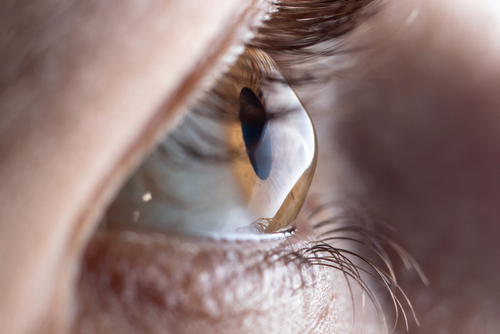
Keratoconus is a progressive eye condition that causes your cornea to be irregularly shaped. In its early stages, the vision symptoms caused by keratoconus can often be corrected by specialty contact lenses.
However, as the condition advances, corneal transplant surgery may be necessary to improve vision. Understanding what keratoconus is and knowing the symptoms of keratoconus can help you get an early diagnosis and appropriate treatment.
Keep reading to learn what the most common symptoms of keratoconus are!
What is Keratoconus?
Keratoconus is a progressive eye condition that causes the cornea to thin and bulge outward in a cone shape. The cornea is the clear, dome-like structure at the front of the eye.
A normal healthy cornea is typically rounded and dome-shaped. This shape is important because the cornea focuses light. A rounded cornea means that light is focused accurately and vision is sharp and clear.
However, with an abnormal cone-shaped cornea, light rays passing through the eye go out of focus, which affects vision and creates other symptoms.
Most Common Symptoms of Keratoconus
Early-stage keratoconus can often be relatively symptom-free. You may be developing the condition and not even know it.
As keratoconus worsens, the following symptoms may appear:
Blurred Vision
Fuzzy, indistinct vision can make it difficult for you to see clearly at any distance.
Glare and Halos
With keratoconus, you may see glare and halos around lights. This is most obvious at night, making nighttime vision difficult and creating more significant challenges for tasks like nighttime driving.
Light Sensitivity
Individuals with keratoconus may be more sensitive to light. Exposure to bright light may cause discomfort or pain.
Distorted Vision
Images will not appear as normal but will look stretched or distorted. Straight lines may appear wavy or bent.
Sudden Vision Changes
Keratoconus can cause sudden worsening or clouding of your vision.
Changes in Glasses Prescriptions
As the cornea changes shape and becomes more cone shaped, vision changes will require more frequent need for a new glasses prescription.
Causes of Keratoconus
Keratoconus appears to be an inherited condition, although other causes are still being determined. There’s a greater chance of developing keratoconus for those who experience eye allergies, excessive eye rubbing, hay fever, and asthma.
There’s some evidence that loss of collagen in the cornea is related to keratoconus. Production and destruction of the corneal tissue by the corneal cells may be imbalanced, leading to the condition.
Keratoconus can first show up at puberty between the ages of ten and twenty-five. The progression of the disease is not easily predicted.
It can worsen over one to two decades or not progress at all. It affects both eyes, though one eye will have more severe symptoms than the other.
Treating Keratoconus
Early-stage blurriness can be corrected by glasses. As keratoconus develops, specially-designed contact lenses are recommended.
Typically these are rigid gas-permeable lenses.
But as the disease worsens, the cone-shaped cornea becomes harder to fit with contact lenses. Surgery is recommended at this stage.
Diagnosing Keratoconus
Keratoconus is diagnosed by an eye doctor who can determine if there are irregularities in the curvature of your cornea. A comprehensive eye exam is recommended for anyone who is experiencing the symptoms of keratoconus.
Do you want to learn more about Keratoconus? Schedule an appointment at Metro Eye Care in Paramus, NJ, today!
